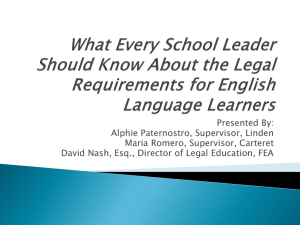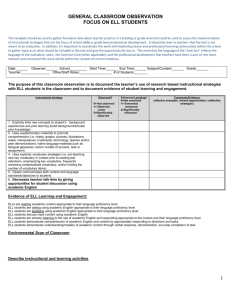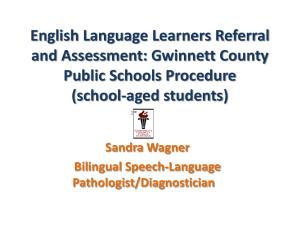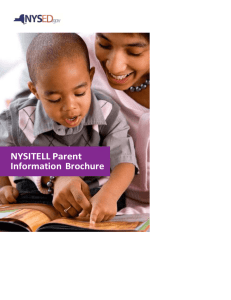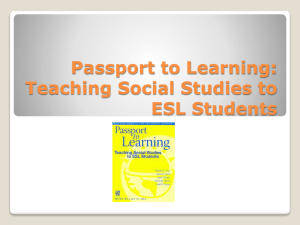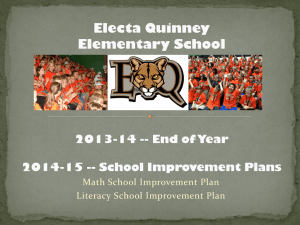ELL 101 for Administrators - Leadership to INtegrate the Early
advertisement
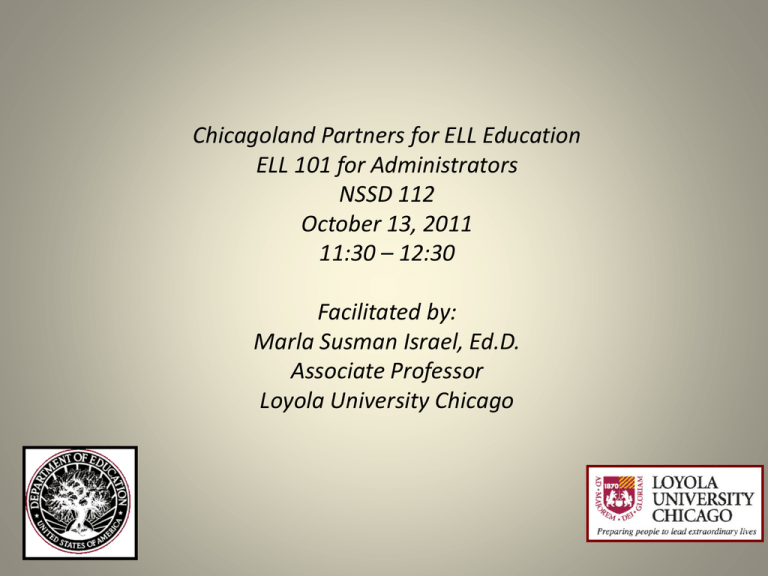
Chicagoland Partners for ELL Education
ELL 101 for Administrators
NSSD 112
October 13, 2011
11:30 – 12:30
Facilitated by:
Marla Susman Israel, Ed.D.
Associate Professor
Loyola University Chicago
Word Sort
• With your tablemates, please sort the words that are in
your envelope.
• You may sort these words into categories, semantic maps,
whatever makes sense to the group.
• You may speak in your native language during the sorting.
You must, however, be able to explain the sorting to others
in English.
• Teaching tip: This can be done as a picture sort for nonEnglish readers. This is a great way to pre-teach vocabulary.
This presentation was made possible by:
Chicagoland Partners For English Language Learners (CPELL) Loyola
University Chicago project funded by the Office of English Language
Acquisition, U.S.
Department of Education School of Education ·
Loyola University Chicago · 820 N. Michigan Avenue, Chicago, Illinois
60611 Phone:312.915.6318 · E-mail: cpell@luc.edu
The teachers at North Shore School District 112
in Cohort 1 & 2:
Melissa Arof, Patricia Castano, Stephanie Labellarte, Beverly Ramirez,
Alison Ryan and Janet Van Arsdale
Today’s Goals
• Understand the Iceberg of Language
• Understand the Nature of Learning a New Language
• Based on research, clarify the outcomes that can and
cannot be achieved using the various ELL models
• Review best ELL teaching practices
• Understand the Iceberg of Culture
• Increase cultural competency and cultural sensitivity
NSSD 112 Mission Statement
• The mission of North Shore School District
112, a community partnership committed to
world-class education, is to nurture every
child to become an inspired learner, a wellrounded individual and contributing member
of a global community by striving for
excellence within an environment that fosters
innovation, respect, engagement and
intellectual inquiry.
Developing new understandings about language and
culture
“Educating all children will require the will and
commitment to understand and respond to
cultural difference. To the extent that teachers
know and understand how children’s past
experiences have been organized and
explained, they are better able to fashion new
ones for them.”
(Bowman & Stott, 1994)
The Iceberg of Language
BICS – Basic Interpersonal Communication Skills: This is
conversational language. Language on the surface.
CALPS – Cognitive Academic Language Proficiency Skills
(academic language) Language of deep understanding.
WIDA
World-Class Instructional Design and Assessment
• Levels of Language Proficiency (measure with ACCESS)
– Listening, Speaking, Reading, Writing
•
•
•
•
•
•
Entering
Beginning
Developing
Expanding
Bridging
Reaching
• Remember, a student can “display” different levels of language
proficiency within BICS and CALPS and within each of the
language skill areas.
• Let us experience what this “feels like” for the ELL student.
Bootstrapping
(Cloud, Genesse, Hamayan, 2009)
• ELL’s use their home language to help them learn English
much the way a child uses the straps to pull on their
boots – it is much easier than if a child just tries to tug
away at the boots themselves.
• Write down how you “bootstrap” as I read to you the
following children’s classic piece of literature.
• How could you make the language more comprehensible
for your students?
Language Minority Education Programs
Early Exit Bilingual Model – Three years out model.
Uses native language as a bridge to target
language. Goal is for child to become fluent in
target language.
Late Exit Bilingual Model – Five to seven years and out
model. Uses native language as a bridge to target
language. Goal is for child to become fluent in the
target language.
Language Minority Education Programs
Maintenance Heritage Language Program – Class
composed of SAME native language speakers. Goal
is to maintain language while learning the target
language.
Dual Language Model – Class is composed of half
native language and half target language speakers.
Goal is for both groups of children to become
bilingual in both languages.
Language Minority Programs
Immersion Model – Sink or swim. Goal is for child to
become fluent in target language.
ELL Model/TPI model (formerly ESL) – Class is
composed of many different native language
speakers. Using specific strategies, students learn
target language through the use of the target
language. Children within each language group
only speak native language to each other. Goal is
for child to become fluent in target language.
Applying the models to NSSD 112
• What should we see in the classroom within
each model?
– Teacher Talk (language)
– Student Product (language)
– Overall Student Goal (language)
• What constitutes success within each model in
NSSD 112?
– Refer to supplemental document
Constructivist/Sheltered Instruction
Theory and Theorists
• Krashen:
• The role of MEANING
• The role of COMPREHENSIBLE INPUT
• The role of LOW ANXIETY
• Cummins
• Proficiency in English used for COMMUNICATIVE
PURPOSES
• Proficiency in English used for ACADEMIC PURPOSES
• EMPOWERMENT OF STUDENTS
• Long
• the role of INTERACTION
Best practices in ELL education
1)
2)
3)
4)
5)
6)
Values prior knowledge
Is context embedded
Integrates cooperative group work
Uses total physical response (gesture)
Uses multidimensional assessment
Integrates language, content, and process
Modify Teacher Talk
•
•
•
•
•
•
•
•
Be aware of idioms (Jodi Reiss, 2008)
Use meaningful gestures
Teacher think alouds
Slow down
Use visuals
Un-clutter the classroom environment
Think-pair-share while teaching
Allow extended wait time
Selecting Words to Teach
(Cloud, Genesee, Hamayan, 2009)
• Select words that are important for understanding the essential
learnings and the text.
• Do not exceed the number of words that student can remember
(around 6 to 10 per lesson, depending on the learners’ age and/or
stage of proficiency.
• Select words that can advance student’s word learning skills (words
with particular prefixes or suffixes for example)
• Teach words that are frequent, useful and likely to be encountered
in the content area. They should be highly transferrable to other
units or content areas.
• Do not directly teach words if students can use context or structural
analysis skills to discover the word’s meaning.
• Be sure that you select an appropriately leveled passage to begin
with, one for which you will only need to teach a small number of
words prior to reading.
Sources for Observing and Evaluating
Teaching and Learning
• WIDA Standards and the Common Core
– www.wida.us (World Class Instructional Design
and Assessment)
-SIOP model (Sheltered Instruction Observation
Protocol) http://www.misd.net/bilingual/ELL.pdf
Application
For the student described in your scenario, answer the
following questions:
• First, using the knowledge gleaned from your classroom
observations of good teaching for all children, what teaching
strategies should you see for your chosen student in the
classroom– be specific.
• Second:
– What data do you have about this student?
– What data do you still need about this student?
– What needs to be communicated amongst the teaching
team members?
– What should possible next steps be for this student?
The Cultural Competency Game
• You have each been given a “label” that everyone can see – except
you.
• When given the “go” sign, you need to get up and ask people about
yourself. People will answer you with a “yes” or “no” answer.
• Move around. Ask multiple people questions until you guess
correctly “who you are.”
• When you know “who you are,” put your sign to the front of your
body.
• Debrief– What types of questions did you ask?
– What types of answers did you give?
– How did you feel during this game?
– What implications does this have for your work?
The Iceberg of Culture
The Iceberg of Culture
“The privatization of moral discourse in our society has
created a deep sense of moral loneliness and moral
illiteracy, the absence of a common language
prevents people from reading about and talking
about the moral issues they face.”
Bolman & Deal: Leading with Soul (1995)
A common feature of culture is that it is a
collective creation.
• That is, people construct their social interactions with
others.
• Cultural ideas are shared by a group of people who
recognize the knowledge, attitudes, and values of one
another.
• These people also agree on which cultural elements are
to adhered to and followed.
Culture is transmitted
across generations by such
people as parents,
teachers, respected elders
and religious leaders.
It is mediated through a variety of sources,
including the media, the stories parents
tell their children, and the various
experiences one has in a given culture’s
institutions and schools.
There exists clear childhood experiences that individuals
can identify that help to develop and
teach particular values and practices.
• Among many in the middle class in the United States
(particularly among certain ethnic groups), individualism
and self-reliance are strongly valued.
• On the contrary, people of some ethnic or cultural
backgrounds strongly value interdependence and a
collective orientation, or a strong group identity.
Ethic of Critique: An ethical lens to develop
intercultural competence
• Whose voice is not considered?
• Whose voice is silenced?
• What does this mean for our work as educators?
Intercultural competence requires that
every member of an educational
community answer four questions for
themselves . . . .
28
What is culture?
29
What modifications and
insights need to be
created as one seeks to
bring culturally different
individuals together?
30
What information (cultural
guideposts) do I need to aid
others in understanding the
culture of school in a way
that facilitates their
acculturation and academic
success?
31
Who are our cultural ambassadors?
Who can hear the silenced voice?
• Administrators, teachers, teacher assistants
• Bus Drivers (see Roger E. Axtell’s {1998} Gestures: The
Do’s and Taboos of Body Language Around the World.
• Crossing Guards
• Food Service Personnel
• School Psychologists/Social Workers
• P.E. Teachers
• School Nurse
• Technology Specialists
Tools for increasing cultural competency
•
•
•
•
•
Be aware of your own biases
Actively listen
Read about other cultures
Spend time with people from other cultures
Immerse yourself in a culture – take the role of
other
• Culturegrams: http://online.culturegrams.com
– Login ID: cpellremote
– Password: library
Thank you and Feedback
• Please visit our website at:
– www.luc.edu/cpell
• You will find symposium power-points for administrators, teachers, and
parents.
• You will find out more about our great CPELL scholars and graduates.
• You will find additional resources to help you serve your ELL students and
families.
• Feedback:
– 2 CPDU forms – complete and turn in the form with the checkboxes;
keep the other form for your records.
– 1 CPELL feedback form – complete and turn in. Please make sure you
mark your position at the top of the form.

